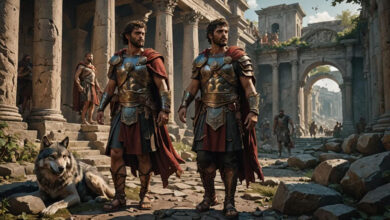Ancient Rome has long been a fascination for historians, archaeologists, and lovers of mythology. The myths and legends of this ancient civilization have captured the imaginations of people for centuries. From the epic tales of gods and goddesses to the heroic adventures of mortal men and women, the myths of ancient Rome are rich with symbolism, moral lessons, and intrigue.
However, like all mythologies, the stories of ancient Rome are often misunderstood and misrepresented. In this article, we will take a closer look at some of the most enduring myths of ancient Rome and separate fact from fiction.
One of the most well-known myths of ancient Rome is the story of Romulus and Remus, the twin brothers who were said to be the founders of the city. According to legend, the twins were abandoned as infants and raised by a she-wolf. As they grew older, they decided to build a city on the spot where they had been found. However, a disagreement over which hill to build the city on led to a fight between the brothers, in which Romulus killed Remus and named the city after himself.
While the story of Romulus and Remus is a foundational myth of ancient Rome, there is little historical evidence to support the existence of these legendary twins. It is more likely that the city of Rome was founded by a group of Latin tribes who settled in the area in the 8th century BC. The story of Romulus and Remus was likely created later as a way to establish a mythic origin for the city and to highlight its divine protection.
Another popular myth of ancient Rome is the story of Aeneas, a Trojan hero who escaped the fall of Troy and journeyed to Italy, where he became the ancestor of the Roman people. According to legend, Aeneas was guided by the goddess Venus and faced many trials and tribulations on his journey. Upon reaching Italy, he founded the city of Lavinium and eventually became the father of Romulus and Remus.
While the story of Aeneas is a central part of Roman mythology, there is little historical evidence to support the existence of this legendary hero. The myth of Aeneas was likely created to establish a connection between the Romans and the Greeks, as the Romans claimed descent from the Trojans and sought to align themselves with the noble traditions of Greek civilization.
One of the most fascinating myths of ancient Rome is the story of the founding of the Roman Republic. According to legend, the Romans overthrew their Etruscan kings and established a new form of government based on the principles of law and citizenship. The founding of the Republic was said to have been a turning point in Roman history, marking the beginning of a period of political and cultural growth.
While the founding of the Roman Republic is a historical fact, the myths surrounding this event often exaggerate the role of individuals such as Brutus, who is famously portrayed as the hero who overthrew the tyrannical king Tarquin. In reality, the transition from monarchy to republic was a gradual process that involved many different people and factions. The story of Brutus and the overthrow of Tarquin is likely a later invention designed to glorify the ideals of the Republic and to justify its establishment.
In addition to these myths, there are many other stories from ancient Rome that have captured the imagination of people throughout history. The legends of Caesar, Cleopatra, and the gladiators are just a few examples of the rich tapestry of myths that have shaped our understanding of this ancient civilization.
While the myths of ancient Rome are certainly fascinating, it is important to remember that they are just that – myths. They are stories that have been passed down through generations, often embellished and altered to suit the needs of the storyteller. By taking a closer look at these myths and separating fact from fiction, we can gain a deeper understanding of the true history and culture of ancient Rome.





